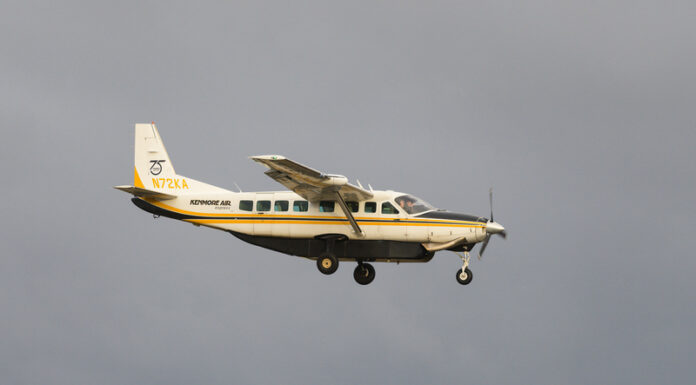A Bering Air Cessna 208B Grand Caravan carrying nine passengers and one pilot disappeared Thursday afternoon, February 6, 2025, during a 146-mile flight from Unalakleet to Nome, Alaska, marking the third major aviation incident in the United States within eight days.
The aircraft, operating as Bering Air Flight 445, departed Unalakleet, Alaska, at 2:40 p.m. local time. Ground controllers lost radar and radio contact at 3:16 p.m., approximately 12 miles offshore over Norton Sound, about 38 minutes into the flight and 10 minutes before its scheduled arrival in Nome. The Federal Aviation Administration issued a Search and Rescue Alert Notice at 3:20 p.m.
Weather conditions severely impacted search operations, reducing visibility to less than half a mile. Rescue crews battled conditions, including light snow, freezing drizzle, wind gusts up to 35 mph, and temperatures around 17 degrees Fahrenheit.
The extensive search operation involved coordinated efforts from multiple agencies. The U.S. Coast Guard deployed specialized search aircraft to conduct grid pattern searches over water and shoreline areas. A National Guard C-130 and an Air Force C-130 were deployed but initially reported finding nothing despite repeated sweeps of the region. The FBI provided technical assistance by attempting to geolocate passengers’ cell phones while analyzing radar data from the plane’s last known position.
Nome and White Mountain crews systematically searched coastal areas between Nome and Topkok. The Norton Sound Health Corporation positioned medical teams strategically along the coast, maintaining readiness for emergency response. The Nome Airport runway remained open, and maintenance crews conducted regular de-icing operations throughout the search effort.
The wreckage of the plane was located on sea ice roughly 30 miles southeast of Nome by the U.S. Coast Guard on Friday, February 7.
On February 8, it was reported that the identities of two victims from the crash had been confirmed as teams worked quickly to retrieve the remains of all 10 passengers before more severe weather arrived. First responders managed to retrieve the bodies of the crash victims from a floating ice floe ahead of the forecasted strong winds and snowfall.
The identified victims on the plane were Rhone Baumgartner, 46, and Kameron Hartvigson, 41, who were in Unalakleet working on a heat recovery system at a local community water plant, as reported by the Alaska Native Tribal Health Consortium. The names of the other victims in the crash have not been made public yet.
The victims of the crash also included a 34-year-old pilot from Nome and a 58-year-old passenger, both residents of Nome.
Rescue teams plan to deploy a Black Hawk helicopter to remove the wreckage from the ice.
“The ice is slushy and young; it’s not stable,” said Jim West, Chief of the Nome Volunteer Fire Department.
The National Transportation Safety Board has dispatched teams to conduct an investigation.
The disappearance follows two recent deadly crashes: a mid-air collision involving two small aircraft near Washington, D.C., and a medical transport plane crash in Philadelphia that resulted in multiple casualties. Alaska’s U.S. senators and congressmen have pledged federal resources to support the ongoing search and rescue operations.
Aviation experts analyzing the incident speculate that ice buildup on the wings could have contributed to the plane’s disappearance. While generally considered reliable in Arctic conditions, the Cessna Caravan remains vulnerable to ice accumulation in severe weather. The aircraft was reportedly in a holding pattern awaiting clearance to land when contact was lost.
Established in 1979, Bering Air is a critical transportation lifeline for over 30 remote Alaskan communities. The family-owned airline maintains a modern fleet of Cessna aircraft, operating scheduled regional service, charter flights, and cargo transport in a region where more than 80% of communities lack road access. The airline has operated in the challenging Arctic environment for over four decades.
Alaska’s unique geography and severe weather have historically contributed to a disproportionate number of aviation incidents. The state accounted for over one-third of all U.S. air taxi and commuter incidents between 1990 and 2015, with winter months presenting particularly challenging conditions for pilots and aircraft.








